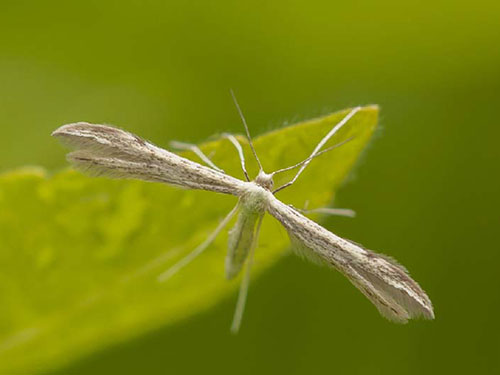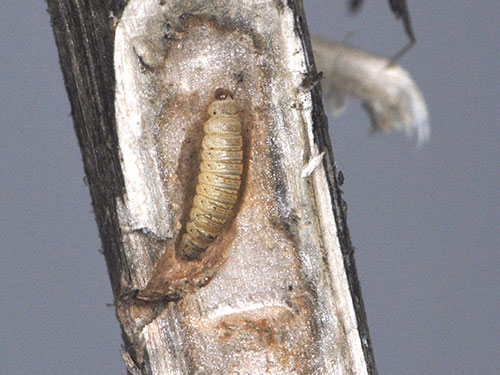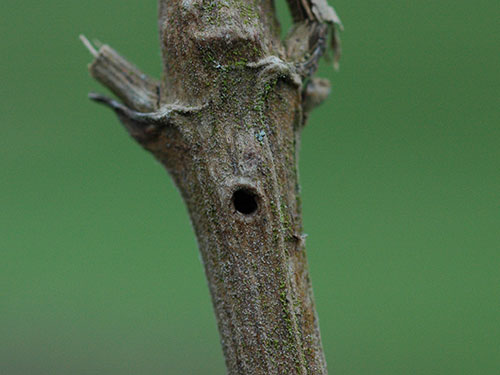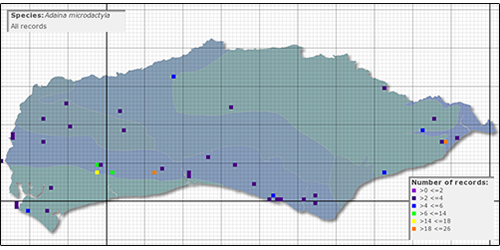


Adult Hemp-agrimony Plume Adaina monodactyla, Rewell Wood
Photo: Colin Knight

Larva of Adaina monodactyla, in stem of Hemp-agrimony
Photo: Colin Hart

Hole produced by Adaina monodactyla larva in gall formed in stem of Hemp-agrimony
Photo: Colin Hart

Distribution of records of Adaina monodactyla in Sussex
Map from Sussex Moth Group website
There are 44 members of the Pterophoridae or plume moth family that occur in the UK of which 30 have been recorded in Sussex. The smallest of these, with a wingspan of around 15 mm, is the Hemp-agrimony Plume Adaina microdactyla, although not rare it isn’t a commonly recorded species but is one that, according to County Recorder, Colin Pratt, is believed to be on the increase in Sussex.
The plumes are all small moths, with a wingspan of no more than about 30 mm. Their wings are deeply cleft or lobed into feathery "plumes", the forewing being divided into two and hindwing into three lobes. They have a distinctive resting posture, standing high up on their legs with their narrow wings overlapping or rolled up and held at about 90° to the body forming a "T-shaped" profile. Species such as Common Plume Emmelina monodactyla and White Plume Moth Pterophorus pentadactyla will be familiar to many, being relatively common and widely distributed species.
Adaina microdactyla is double-brooded, the adults, which when newly emerged are a pale greenish-yellow colour, can be seen flying from mid May to mid June and again from mid July to late August. It hibernates as a fully-grown larva in the dead, grey-coloured stem of the foodplant, Hemp-agrimony Eupatorium cannabinum, on damp riverbanks and places on the downs, and can be found throughout the winter and early spring. The larva feeds in the upper half of the stem often at or near a leaf or stem node. It eats the living pith during August and September often causing the flowers above the feeding point to abort. In thick stems there is little sign of feeding, but thinner stems form a swelling or gall. When fully grown the larva may overwinter in situ, or move down the stem and form a new gall as a hibernaculum. The overwintering gall will have a 1.5 mm hole in the side partly plugged with a pointed pellet of silk. To confirm the species split open the stem with a thumbnail or knife and the larva will be sitting in a flimsy cocoon across the width of the stem and slightly higher than the hole. The larva is creamy-white with a brown head 6-7 mm long and cigar-shaped. There is a broad but faint dorsal band of dark brownish grey becoming wider towards the head and tail. Keep the stems with larvae in an outhouse, slightly damp, and the larva will pupate when the weather warms up in April and emerge about a month later.
If you find any stands of Hemp-agrimony (maybe when you are out looking for Brown Hairstreak eggs?) spend a bit of time examining the stems for these tell-tale larval feeding signs. If you find anything, please submit the details with some photos to iRecord, or by email to bobforeman@sussexwt.org.uk with details of location, grid reference and date found.
Every month it is our aim to highlight a species that is “in-season” and, although not necessarily rare or difficult to identify, has been highlighted by our local recording groups as being somewhat under-recorded and for which new records would therefore be welcomed.
If you or your recording group are aware of species such as this then please contact Bob Foreman.